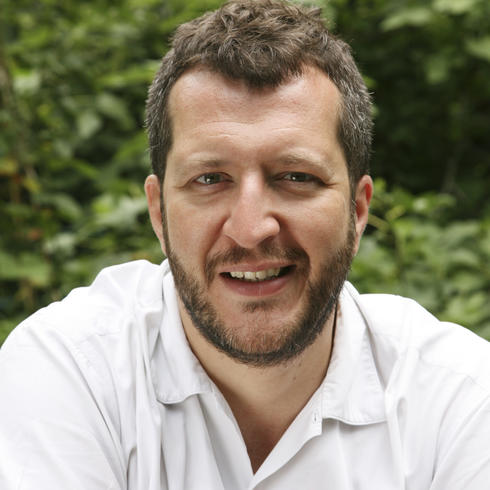Totentanz is a setting for two voices and full orchestra of the text accompanying a frieze which hung in the Marienkirche, Lübeck, Germany, depicting every member of society in the Danse Macabre in descending order, beginning with the Pope and ending with the baby. The part of Death is taken by a baritone, and all the human race sung by a mezzo-soprano. It is dedicated to the memory of Witold Lutos?awski and received its world première at the BBC Proms in 2013.
Thomas Adès
Dance, wild but tightly controlled, and all the wilder for being so, dance at once intoxicating and sinister, dance that takes over our bodies as its own – such involving and intemperate dance has been a feature of Adès’s music at least since the third movement of his Asyla. Here it is again, more so than ever before.
The Totentanz, or Dance of Death, was a topic that gripped Europe in the fifteenth century, perhaps because Renaissance humanism, which placed increasing value on the individual life, was coming up against our common human fate. Adès took his image of this ultimate dance, and his text, from a thirty-metre-long hanging of painted cloth made in 1463 for the church of St Mary in the German Baltic city of Lübeck. Itself subject to mortality, the hanging was replaced by a copy at the beginning of the eighteenth century, and that copy was destroyed during World War II. Reproductions of it, though, have survived, and these for Adès were enough. They showed Death linking hands with representatives of humanity at all levels, addressing each differently in the underlying captions, but with the same ineluctable message, to which each responds, generally with sorrowful resignation.
Adès cuts the cast of human characters from twenty-three to sixteen, adapts the words, and sets Death’s part for a declamatory yet lyrical baritone, while a mezzo-soprano sings for all his victims. In the text, the two voices largely alternate, but with the important difference that where each of the human beings replies directly to Death’s invitation to the dance, Death is always moving on to the next. Adès varies this back-and-forth dialogue in the later stages of his work, but still it remains the case that human reactions, variously expressed as they may be, are all futile. Death is not a great listener.
The interplay between one who only declares and those who hear and answer, between statement and response, between reiterated summons and ever renewed lament, is thrust forward by and within an immense orchestral machine, involving a large percussion section. This machine, we might imagine, gives us the voice of Death’s great ally, Time, which enters with a surge onto whacking chords and then, in octaves across the whole orchestra, introduces the baritone to present, as preacher, this coming ‘play’.
Even while the preacher is addressing us, the dance, which swirls and swells on from an initial oscillation, is already beginning – a piccolo starts it – but it really gets going when the baritone takes on the voice of Death, to call first on the pope. Death’s proposal is different every time, shaped towards the intended recipient, and, in a score that also features incidental word-painting, each human character has a different voice, and a different orchestra. The pope, for instance, sings with upper strings in free rhythm, the cardinal with woodwind and strings in flowing quavers that are perhaps seeking a way out – and fittingly it is here that Death first re-enters, to create a duet. A score of constant variety and telling detail results from the changing scenes, even while the dance is all the time waiting in the wings, ready now and then, between these wasted discussions, to bound forward again.
There are also moments of stillness, of an exquisitely expressed emptiness, as in the dialogue with the monk. Then, after the knight has had his say, with soft drumming and the dance in the oboes, Death becomes more impatient, and rushes through the mayor, the doctor and the usurer. After this comes a slow duet for Death and the merchant, their voices moving together as the orchestra readies itself for the climactic eruption of dance. For a moment this seems to exhaust Death, and he allows the parish clerk to have his say – in a passage of fine pianissimos – before for once chiming in second, lyrically. Two further long scenes follow, with the craftsman (a self-portrait) and the peasant, ‘perhaps representing’, the composer suggests, ‘the extreme opposite poles of human resistance and acceptance, and of Death’s animosity or lack of it.’ From this point we may feel that the dance of death is becoming more a love song of death, leading on to another pianissimo sequence, with the maiden.
Now there remains only, alone in the world, a child. The child has few words, repeating them over and over, with growing passion, before sinking into Death’s arms.
Totentanz was commissioned by Robin Boyle in memory of Witold Lutoslawki (1913-1994) and of his wife Danuta.


